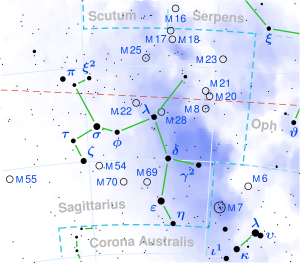7 Sagittarii is a massive star in the southern zodiac constellation of Sagittarius which is located in the Lagoon Nebula (NGC 6530),[9] although multiple sources have considered it a foreground star.[10] It is a dim star but visible to the naked eye with an apparent visual magnitude of 5.37.[2] The distance to this star can be determined from the annual parallax shift of 3.02±0.28 mas,[1] yielding a value of roughly 1,100 light years. It is moving closer to the Sun with a heliocentric radial velocity of −11 km/s.[5]
| Observation data Epoch J2000 Equinox J2000 | |
|---|---|
| Constellation | Sagittarius |
| Right ascension | 18h 02m 51.09872s[1] |
| Declination | −24° 16′ 56.8825″[1] |
| Apparent magnitude (V) | 5.37[2] |
| Characteristics | |
| Spectral type | F2 II/III[3] |
| U−B color index | 0.25[4] |
| B−V color index | 0.51[4] |
| Astrometry | |
| Radial velocity (Rv) | −11.2±1.0[5] km/s |
| Proper motion (μ) | RA: +1.22[1] mas/yr Dec.: −17.52[1] mas/yr |
| Parallax (π) | 3.02 ± 0.28 mas[1] |
| Distance | 1,100 ± 100 ly (330 ± 30 pc) |
| Absolute magnitude (MV) | −2.21[2] |
| Details | |
| Radius | 18[6] R☉ |
| Luminosity | 658.07[2] L☉ |
| Surface gravity (log g) | 3.54±0.20[5] cgs |
| Temperature | 6,800±200[5] K |
| Metallicity [Fe/H] | 0.0[5] dex |
| Rotational velocity (v sin i) | 35[7] km/s |
| Other designations | |
| Database references | |
| SIMBAD | data |

Gray and Garrison (1989) listed a stellar classification of F2 II/III[3] for this star, suggesting it is a K-type star with a spectrum showing mixed traits of a giant/bright giant. Houk and Smith-Moore (1978) had a similar classification of F2/3 II/III.[11] This may indicate it is not a member of NGC 6530, since it should not have evolved to this class from the O-type stars that still populate this cluster, and hasn't had time to evolve from a less massive cluster star.[10]
It is a suspected chemically peculiar star.[4][5] The spectral class from the calcium K line has been given as A8 while the class determined from other metallic lines was F4, making it an Am star.[12] This peculiarity is now considered doubtful.[4]
7 Sagittarii has an estimated 18[6] times the Sun's radius and is radiating 658[2] times the Sun's luminosity from its photosphere at an effective temperature of around 6,800 K.[5]
References
edit- ^ a b c d e f van Leeuwen, F. (2007), "Validation of the new Hipparcos reduction", Astronomy and Astrophysics, 474 (2): 653–664, arXiv:0708.1752, Bibcode:2007A&A...474..653V, doi:10.1051/0004-6361:20078357, S2CID 18759600.
- ^ a b c d e Anderson, E.; Francis, Ch. (2012), "XHIP: An extended hipparcos compilation", Astronomy Letters, 38 (5): 331, arXiv:1108.4971, Bibcode:2012AstL...38..331A, doi:10.1134/S1063773712050015, S2CID 119257644.
- ^ a b Gray, R. O.; Garrison, R. F. (February 1989), "The early F-type stars: refined classification, confrontation with Stroemgren photometry, and the effects of rotation", Astrophysical Journal Supplement, 69: 301, Bibcode:1989ApJS...69..301G, doi:10.1086/191315.
- ^ a b c d Renson, P.; Manfroid, J. (May 2009), "Catalogue of Ap, HgMn and Am stars", Astronomy and Astrophysics, 498 (3): 961–966, Bibcode:2009A&A...498..961R, doi:10.1051/0004-6361/200810788
- ^ a b c d e f g Khalack, V.; LeBlanc, F. (July 2015), "Project VeSElkA: Analysis of Balmer Line Profiles of Slowly Rotating Chemically Peculiar Stars", The Astronomical Journal, 150 (1): 10, arXiv:1505.08158, Bibcode:2015AJ....150....2K, doi:10.1088/0004-6256/150/1/2, S2CID 118283214, 2.
- ^ a b Pasinetti Fracassini, L. E.; et al. (February 2001), "Catalogue of Apparent Diameters and Absolute Radii of Stars (CADARS)", Astronomy and Astrophysics, 367 (Third ed.): 521–524, arXiv:astro-ph/0012289, Bibcode:2001A&A...367..521P, doi:10.1051/0004-6361:20000451, S2CID 425754.
- ^ Rutten, R. G. M.; Pylyser, E. (February 1988), "Magnetic structure in cool stars. XV. The evolution of rotation rates and chromospheric activity of giants", Astronomy and Astrophysics, 191: 227−236, Bibcode:1988A&A...191..227R.
- ^ "7 Sgr". SIMBAD. Centre de données astronomiques de Strasbourg. Retrieved 2018-03-14.
- ^ Damiani, F.; et al. (August 2017), "The Gaia-ESO Survey: dynamics of ionized and neutral gas in the Lagoon nebula (M 8)", Astronomy & Astrophysics, 604: 25, arXiv:1705.08194, Bibcode:2017A&A...604A.135D, doi:10.1051/0004-6361/201730986, S2CID 119488696, A135.
- ^ a b Sowell, James R. (May 1987), "Yellow evolved stars in open clusters", Astrophysical Journal Supplement Series, 64: 241−267, Bibcode:1987ApJS...64..241S, doi:10.1086/191196. See NGC 6530 on p. 257.
- ^ Houk, Nancy; Smith-Moore, M. (1978), Michigan catalogue of two-dimensional spectral types for the HD stars, vol. 4, Ann Arbor: Dept. of Astronomy, University of Michigan, Bibcode:1988mcts.book.....H.
- ^ Hauck, B. (June 1973), "Catalogue of AM stars with known spectral types", Astronomy and Astrophysics Supplement, 10: 385, Bibcode:1973A&AS...10..385H.
